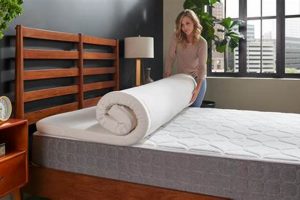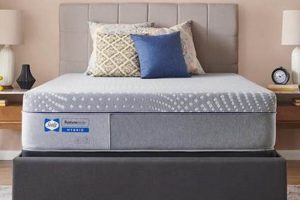The selection of sleep surfaces often involves a spectrum ranging from yielding to resistant. This characteristic influences the degree to which the body conforms to the sleeping platform. For example, one individual might choose a sleeping surface that allows for significant sinking and contouring, while another might prefer a surface that offers substantial resistance and support.
The appropriateness of either option significantly impacts spinal alignment, pressure distribution, and overall sleep quality. Historically, preferences have shifted, reflecting evolving understandings of ergonomics and material science. The correct selection can contribute to reduced back pain, improved circulation, and a more restful sleep experience.
The following sections will delve into the specific characteristics, advantages, and potential drawbacks of each type, along with factors to consider when making a selection based on individual needs and physiological considerations.
Guidance on Sleeping Surface Selection
The following guidance assists in selecting a sleep surface that aligns with individual needs and promotes optimal sleep health. Consider these factors carefully when evaluating options.
Tip 1: Consider Body Weight and Sleeping Position: Individuals with higher body weights generally benefit from more supportive surfaces to prevent excessive sinking. Side sleepers often require a more conforming surface to alleviate pressure on the shoulders and hips, while back sleepers typically need a balance of support and comfort to maintain spinal alignment. Stomach sleepers usually require firm surface.
Tip 2: Assess Spinal Alignment: Proper spinal alignment is crucial for minimizing back pain and promoting restful sleep. Evaluate whether the chosen surface maintains the natural curvature of the spine in the preferred sleeping position. A neutral spine is the key.
Tip 3: Evaluate Pressure Point Relief: Pay attention to pressure points, particularly in the shoulders, hips, and knees. Surfaces that effectively distribute weight can help reduce pressure and prevent discomfort, leading to better sleep quality. This is more important on firmer surfaces.
Tip 4: Consider Material Composition: The materials used in construction significantly impact performance. Memory foam conforms to the body, while latex offers responsiveness and support. Innerspring systems provide traditional support, and hybrid models combine different materials for a balanced feel.
Tip 5: Assess Partner Disturbance: If sharing a bed, consider motion isolation properties. Materials like memory foam excel at absorbing movement, minimizing disturbance to a sleep partner. Also, thickness is important.
Tip 6: Research Available Trial Periods and Warranties: Most reputable manufacturers offer trial periods, allowing for in-home testing. Review the warranty to understand coverage against defects and premature wear.
Tip 7: Factor in Medical Conditions: Individuals with specific medical conditions, such as arthritis or fibromyalgia, should consult with a healthcare professional to determine the most suitable sleeping surface. Consider specialist recommendations.
Proper consideration of these factors will aid in selecting a sleeping surface that promotes restful sleep and supports long-term health and well-being. The following section will delve deeper into advanced considerations.
1. Spinal Alignment
Maintaining proper spinal alignment during sleep is critical for musculoskeletal health and overall well-being. The selection of a sleep surface, specifically the relative resistance to compression, directly influences the degree to which spinal alignment is supported.
- Contour and Support Balance
A sleeping surface must offer both adequate contouring to accommodate the body’s natural curves and sufficient support to prevent excessive sinking. An inappropriately yielding surface may cause the spine to curve unnaturally, leading to strain and discomfort. Conversely, an overly resistant surface may fail to conform to the body’s contours, resulting in pressure points and inadequate support for the spinal column.
- Influence of Sleeping Position
Spinal alignment needs differ based on the individual’s primary sleeping position. Side sleepers require adequate compression of the surface to allow the shoulder and hip to sink in sufficiently, maintaining a straight spinal line. Back sleepers necessitate a surface that supports the natural curvature of the lower back. Stomach sleepers generally benefit from firmer surfaces that minimize arching of the spine.
- Impact on Muscular Relaxation
When the spine is properly aligned, the surrounding muscles can relax more fully, promoting restful sleep. Misalignment can lead to muscle tension and spasms, disrupting sleep patterns and potentially contributing to chronic pain conditions. The selected surface should facilitate muscle relaxation by providing appropriate support and minimizing stress on the spine.
- Long-Term Musculoskeletal Health
Consistent maintenance of proper spinal alignment during sleep can contribute to long-term musculoskeletal health. Conversely, prolonged misalignment can contribute to conditions such as chronic back pain, sciatica, and degenerative disc disease. The correct surface, chosen in conjunction with proper sleeping posture, is an investment in spinal health.
Therefore, careful consideration of the interplay between spinal alignment and the selected sleeping surface is essential. Individual needs and preferences should be balanced with the biomechanical requirements of maintaining a neutral spinal posture during sleep.
2. Pressure Distribution
The evenness with which body weight is supported directly affects comfort and musculoskeletal health. The mechanical properties of a sleep surface, in particular its resistance to compression, dictate how pressure is distributed across the body. Surface selection therefore necessitates an understanding of the relationship between surface characteristics and pressure mapping.
- Role of Surface Compliance
Surface compliance, or the degree to which a surface conforms to the body, is a primary determinant of pressure distribution. A highly compliant surface will contour to the body’s shape, increasing the contact area and reducing pressure concentration at specific points, such as the hips and shoulders. An example of this is memory foam, which molds to the body, spreading weight more evenly. Conversely, a less compliant surface will provide more localized support, potentially leading to pressure points.
- Impact on Circulation
Localized pressure can impede blood flow, leading to discomfort and restlessness during sleep
. Reduced circulation due to concentrated pressure can also contribute to the development of pressure ulcers in individuals with limited mobility. A sleep surface that effectively distributes pressure minimizes the risk of circulatory compromise, promoting more restful sleep. - Influence of Sleeping Position
Sleeping position significantly influences pressure distribution. Side sleepers experience greater pressure on the shoulders and hips, necessitating a surface that provides adequate cushioning in these areas. Back sleepers require support for the lumbar region to maintain spinal alignment without creating pressure points. Stomach sleepers may experience pressure on the chest and abdomen, potentially impacting breathing and requiring a firmer surface to maintain spinal alignment and reduce pressure.
- Material Composition Effects
The material composition of a sleep surface directly affects its pressure distribution characteristics. Latex, for example, offers a balance of support and compliance, distributing weight effectively while maintaining responsiveness. Innerspring systems distribute weight across the coils, but may not provide the same degree of contouring as memory foam or latex. Hybrid systems combine different materials to achieve a desired balance of pressure distribution and support.
Effective pressure distribution is crucial for sleep quality and musculoskeletal health. Selection of a sleep surface should consider individual sleeping position, body weight, and material properties to optimize pressure distribution and minimize the risk of discomfort and circulatory compromise.
3. Body Weight
Body weight significantly influences the selection of a sleep surface, impacting both comfort and long-term musculoskeletal health. The relationship between body weight and surface characteristics must be carefully considered to ensure adequate support and pressure distribution.
- Support and Sinkage
Individuals with higher body weights require sleeping surfaces that provide greater support to prevent excessive sinkage. A surface that yields too readily can lead to spinal misalignment and increased pressure on joints, resulting in discomfort and potential pain. For example, an individual weighing over 250 pounds will generally require a firmer surface compared to someone weighing less than 150 pounds to maintain proper spinal alignment.
- Material Density and Durability
Higher body weights exert greater stress on the materials used in a sleeping surface, potentially affecting its durability and longevity. Denser materials, such as high-density foam or innerspring systems with a higher coil count, are better equipped to withstand the increased pressure and maintain their structural integrity over time. Regular rotation of the sleeping surface can further mitigate wear and tear.
- Pressure Distribution Considerations
Effective pressure distribution is particularly important for individuals with higher body weights to minimize the risk of pressure point development. Surfaces that conform to the body’s contours, such as memory foam or latex, can help distribute weight more evenly, reducing localized pressure on areas like the hips and shoulders. The thickness of the comfort layers should also be considered, as thicker layers generally provide better pressure relief.
- Long-Term Spinal Health
The selection of an appropriate sleeping surface based on body weight is crucial for long-term spinal health. Consistent use of a surface that provides inadequate support can contribute to chronic back pain, disc degeneration, and other musculoskeletal issues. Consulting with a healthcare professional or sleep specialist can provide personalized recommendations based on individual needs and health conditions.
Ultimately, the interaction between body weight and sleeping surface characteristics is a critical determinant of sleep quality and musculoskeletal well-being. Careful consideration of support, durability, pressure distribution, and long-term spinal health is essential in selecting a sleep surface that meets individual needs and promotes restful sleep.
4. Sleeping Position
The preferred position assumed during sleep significantly influences the choice of a sleep surface. The relative resistance of that surface to compression, whether yielding or firm, interacts with the body’s geometry in that position to affect spinal alignment, pressure distribution, and overall sleep quality.
- Side Sleeping and Surface Compliance
Side sleeping concentrates pressure on the shoulder and hip. A surface that is too resistant will create pressure points, potentially leading to discomfort and disrupted sleep. A more compliant surface allows these areas to sink in, maintaining spinal alignment and reducing pressure. However, excessive sinkage can also misalign the spine. Thus, the ideal surface for a side sleeper provides a balance of support and compliance.
- Back Sleeping and Lumbar Support
Back sleeping requires support for the natural curvature of the lumbar spine. A surface that is too yielding may allow the hips to sink too deeply, flattening the lower back and causing strain. A firmer surface provides the necessary support to maintain the natural curvature, but excessive resistance can create pressure points. The optimal surface distributes weight evenly while maintaining spinal alignment.
- Stomach Sleeping and Spinal Extension
Stomach sleeping often leads to hyperextension of the lumbar spine, potentially causing lower back pain. A firmer surface is generally recommended to minimize this extension. A surface that is too compliant will allow the abdomen to sink, exacerbating the spinal curvature. While stomach sleeping is often discouraged, a firm surface can mitigate some of the associated risks.
- Combination Sleeping and Balanced Support
Many individuals shift positions throughout the night. In such cases, a surface with balanced support characteristics is often preferable. Medium-firmness options can accommodate a range of sleeping positions, providing adequate support for back sleeping while still offering some compliance for side sleeping. Hybrid surfaces, combining different materials, can also provide this balance.
Therefore, understanding the relationship between preferred sleeping position and surface characteristics is crucial for selecting a sleeping surface that promotes spinal alignment, pressure distribution, and overall sleep quality. Individual preferences and specific musculoskeletal needs should be considered in conjunction with these general guidelines.
5. Material Density
Material density within sleep surfaces serves as a primary determinant of support characteristics and overall longevity. It dictates the degree to which a sleep surface resists compression, influencing its perceived firmness and suitability for different individuals and sleeping positions.
- Core Support and Sinkage Prevention
Higher density
materials provide enhanced core support, preventing excessive sinkage, particularly for individuals with higher body weights. For example, a high-density foam core in an innerspring surface minimizes sagging and maintains spinal alignment. Conversely, lower density materials offer less support and are more prone to compression, which can result in discomfort and postural issues over time. This is critical in surfaces advertised to be more resistant. - Surface Responsiveness and Conformance
Material density affects the responsiveness and conformance of a surface. Lower density foams, while offering less support, tend to conform more readily to the body’s contours, providing enhanced pressure relief. Conversely, higher density materials offer greater resistance and may not conform as closely, potentially leading to pressure points. The specific needs of the end user, should dictate the surface.
- Durability and Lifespan
Density directly correlates with the durability and lifespan of a sleep surface. Higher density materials are more resistant to wear and tear, maintaining their structural integrity and support characteristics for a longer period. Lower density materials are more susceptible to degradation and compression over time, resulting in a shorter lifespan and reduced support. Warranties do not always account for this degradation.
- Thermal Properties and Breathability
Material density also influences thermal properties and breathability. Higher density materials tend to retain more heat, potentially leading to discomfort for some individuals. Lower density materials often allow for better air circulation, promoting a cooler sleep environment. Manufacturing processes such as open-cell foam structures aim to mitigate heat retention in higher density materials.
The interplay between material density and other factors, such as construction and design, ultimately determines the overall performance and suitability of a sleep surface. A careful evaluation of material density in relation to individual needs is essential for selecting a surface that promotes restful sleep and long-term musculoskeletal health.
Frequently Asked Questions
The following addresses common inquiries concerning the selection of sleep surfaces. This information aims to provide clarity and facilitate informed decision-making.
Question 1: How does one determine the ideal firmness level for optimal spinal alignment?
Optimal spinal alignment is contingent upon individual physiology and preferred sleep position. Side sleepers generally require a more compliant surface to accommodate shoulder and hip compression, while back sleepers benefit from a firmer surface that supports the lumbar curve. Evaluation should involve a trial period to assess alignment and comfort.
Question 2: What impact does body weight have on the selection process?
Body weight significantly influences the degree of support required. Individuals with higher body mass necessitate surfaces with increased resistance to compression to prevent excessive sinkage and maintain proper spinal alignment. Density and material composition are critical factors to consider.
Question 3: How should pressure point relief be evaluated in different sleeping positions?
Pressure points typically manifest at the shoulders, hips, and knees. Side sleepers should assess pressure relief at the shoulder and hip, while back sleepers should focus on lumbar support and hip comfort. Stomach sleepers need to ensure minimal pressure on the rib cage. Proper pressure distribution is indicated by a lack of localized discomfort.
Question 4: What materials are best suited for minimizing partner disturbance?
Materials with high motion isolation properties effectively absorb movement, minimizing disturbance to a sleeping partner. Memory foam and latex are known for their motion isolation capabilities. Innerspring systems, particularly those with individually pocketed coils, can also reduce motion transfer.
Question 5: What considerations should be made for individuals with pre-existing medical conditions?
Individuals with conditions such as arthritis, fibromyalgia, or back pain should consult with a healthcare professional to determine appropriate sleeping surface characteristics. Specific recommendations may include specialized materials or adjustable surfaces to accommodate individual needs.
Question 6: How crucial is a trial period before committing to a purchase?
A trial period is essential for assessing the suitability of a sleeping surface. In-home testing allows for evaluation of comfort, support, and spinal alignment over an extended period, providing valuable insight into the surface’s long-term performance and compatibility with individual sleep habits.
The selection process should be approached methodically, considering individual needs, physical characteristics, and pre-existing conditions. Informed decision-making is crucial for optimizing sleep quality and promoting long-term health.
The subsequent section delves into the correlation with various sleep disorders and their potential mitigation.
Sleeping Surface Selection
The analysis of sleep surfaces reveals the nuanced interplay between resistance to compression, body mechanics, and individual physiology. The determination between a yielding or resistant sleep platform necessitates careful consideration of spinal alignment, pressure distribution, body weight, preferred sleeping position, and material density. These factors collectively influence sleep quality and long-term musculoskeletal health.
Selecting an appropriate sleep surface represents a significant investment in well-being. Continued awareness of the relationship between surface characteristics and individual needs promotes informed decision-making, fostering restful sleep and contributing to overall physical health. Further research may elucidate additional factors impacting the selection process and optimizing sleep quality.



![Best Mattresses at Mattress Firm Anderson SC [Deals] Organic & Natural Mattress Buyer’s Guide: Non-Toxic Sleep Solutions Best Mattresses at Mattress Firm Anderson SC [Deals] | Organic & Natural Mattress Buyer’s Guide: Non-Toxic Sleep Solutions](https://mattressworldpa.com/wp-content/uploads/2025/07/th-9027-300x200.jpg)



